Integrative Review: Leadership, Motivation, and Organizational Impact
VerifiedAdded on 2022/12/26
|8
|1946
|76
Report
AI Summary
This report provides an integrative review of leadership and motivation, delving into the core concepts and theories that drive individual and organizational performance. It begins by exploring the differences between intrinsic and extrinsic motivation, drawing upon Self-Determination Theory to explain the nuances of various motivational drivers. The report then examines three distinct leadership styles: transactional, transformational, and charismatic, highlighting their unique characteristics and approaches to influencing followers. It analyzes which forms of motivation are most likely to be generated by each leadership style, offering insights into how leaders can effectively inspire and guide their teams. The report concludes by summarizing the key findings and emphasizing the importance of both leadership and motivation in achieving organizational objectives. The report includes references to relevant books and journals that support the review of the concepts.
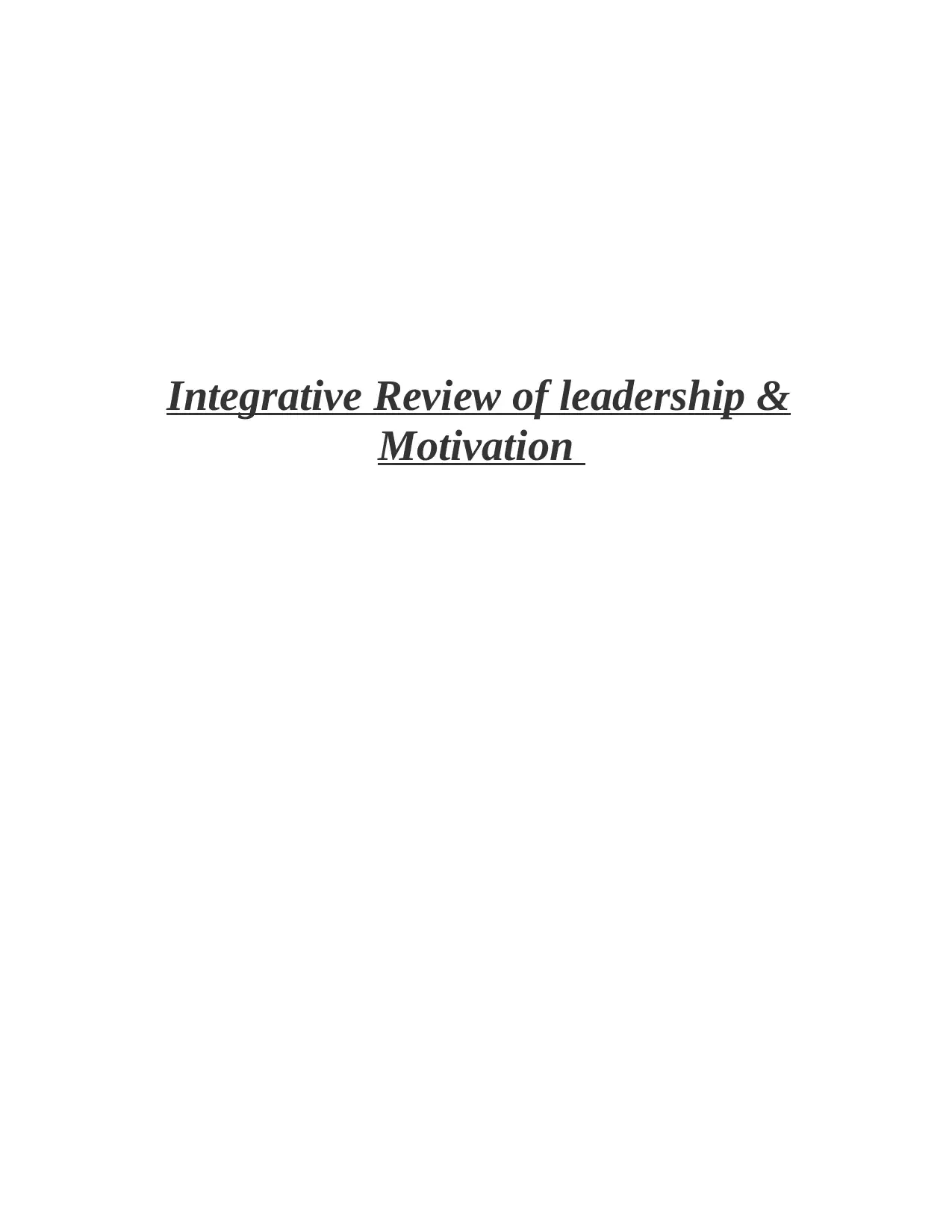
Integrative Review of leadership &
Motivation
Motivation
Paraphrase This Document
Need a fresh take? Get an instant paraphrase of this document with our AI Paraphraser
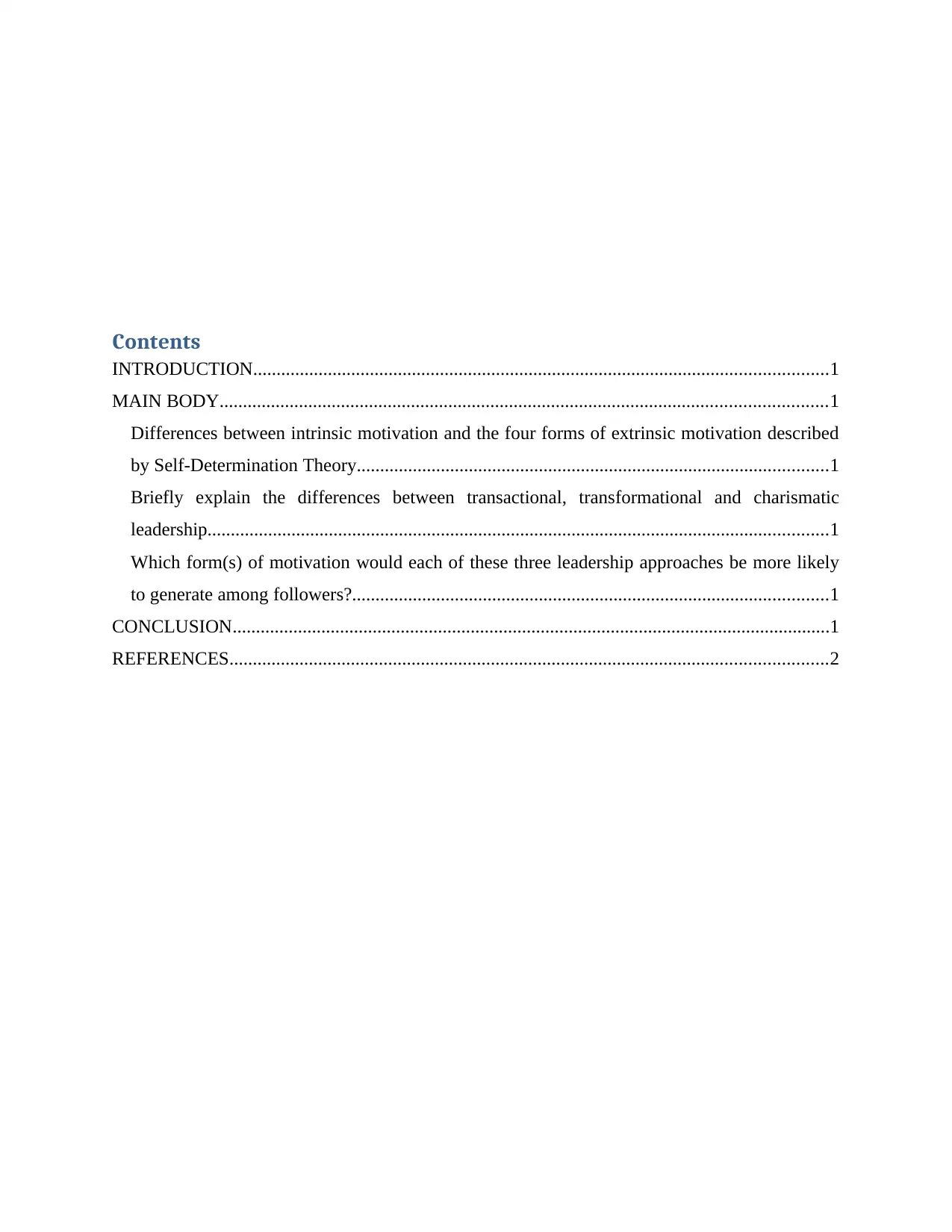
Contents
INTRODUCTION...........................................................................................................................1
MAIN BODY..................................................................................................................................1
Differences between intrinsic motivation and the four forms of extrinsic motivation described
by Self-Determination Theory.....................................................................................................1
Briefly explain the differences between transactional, transformational and charismatic
leadership.....................................................................................................................................1
Which form(s) of motivation would each of these three leadership approaches be more likely
to generate among followers?......................................................................................................1
CONCLUSION................................................................................................................................1
REFERENCES................................................................................................................................2
INTRODUCTION...........................................................................................................................1
MAIN BODY..................................................................................................................................1
Differences between intrinsic motivation and the four forms of extrinsic motivation described
by Self-Determination Theory.....................................................................................................1
Briefly explain the differences between transactional, transformational and charismatic
leadership.....................................................................................................................................1
Which form(s) of motivation would each of these three leadership approaches be more likely
to generate among followers?......................................................................................................1
CONCLUSION................................................................................................................................1
REFERENCES................................................................................................................................2
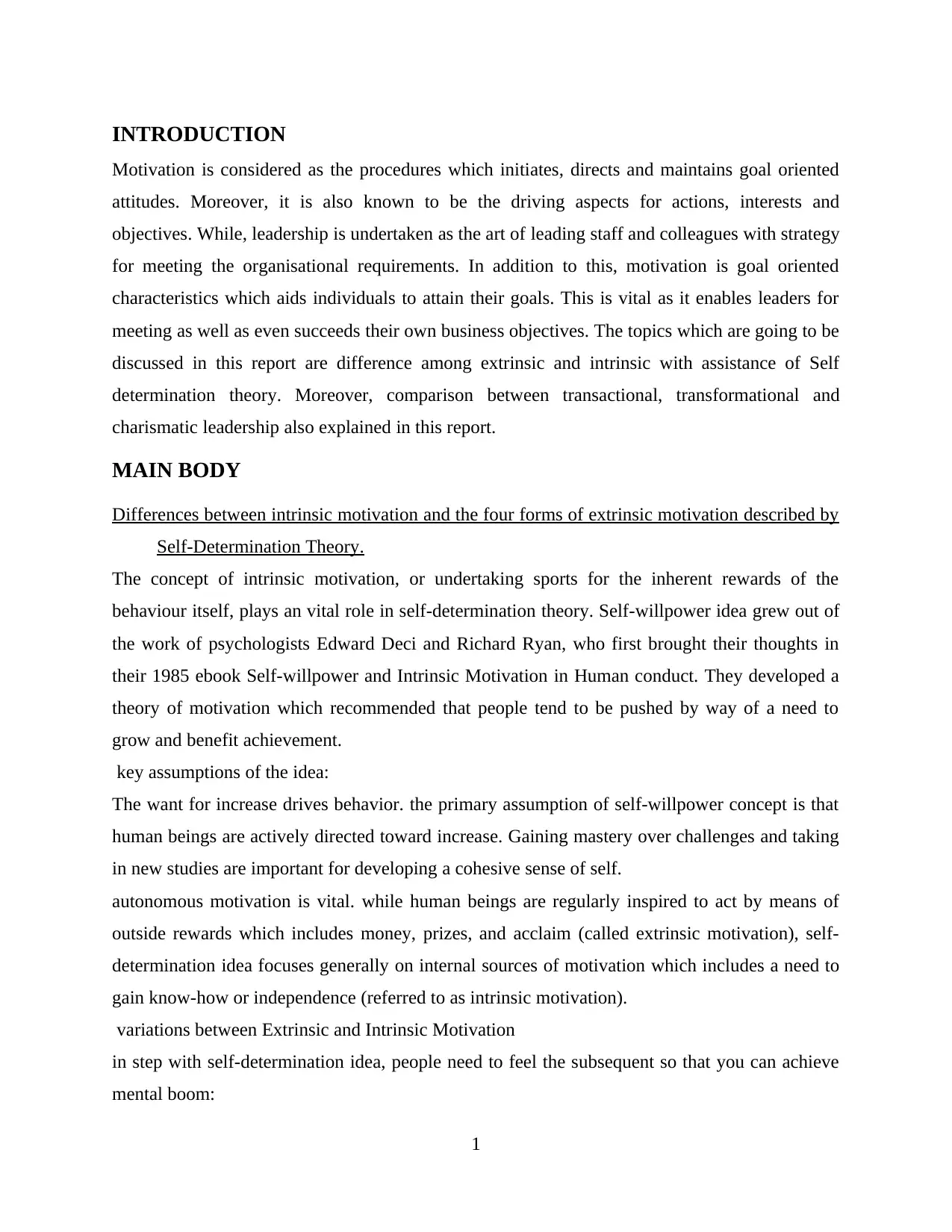
INTRODUCTION
Motivation is considered as the procedures which initiates, directs and maintains goal oriented
attitudes. Moreover, it is also known to be the driving aspects for actions, interests and
objectives. While, leadership is undertaken as the art of leading staff and colleagues with strategy
for meeting the organisational requirements. In addition to this, motivation is goal oriented
characteristics which aids individuals to attain their goals. This is vital as it enables leaders for
meeting as well as even succeeds their own business objectives. The topics which are going to be
discussed in this report are difference among extrinsic and intrinsic with assistance of Self
determination theory. Moreover, comparison between transactional, transformational and
charismatic leadership also explained in this report.
MAIN BODY
Differences between intrinsic motivation and the four forms of extrinsic motivation described by
Self-Determination Theory.
The concept of intrinsic motivation, or undertaking sports for the inherent rewards of the
behaviour itself, plays an vital role in self-determination theory. Self-willpower idea grew out of
the work of psychologists Edward Deci and Richard Ryan, who first brought their thoughts in
their 1985 ebook Self-willpower and Intrinsic Motivation in Human conduct. They developed a
theory of motivation which recommended that people tend to be pushed by way of a need to
grow and benefit achievement.
key assumptions of the idea:
The want for increase drives behavior. the primary assumption of self-willpower concept is that
human beings are actively directed toward increase. Gaining mastery over challenges and taking
in new studies are important for developing a cohesive sense of self.
autonomous motivation is vital. while human beings are regularly inspired to act by means of
outside rewards which includes money, prizes, and acclaim (called extrinsic motivation), self-
determination idea focuses generally on internal sources of motivation which includes a need to
gain know-how or independence (referred to as intrinsic motivation).
variations between Extrinsic and Intrinsic Motivation
in step with self-determination idea, people need to feel the subsequent so that you can achieve
mental boom:
1
Motivation is considered as the procedures which initiates, directs and maintains goal oriented
attitudes. Moreover, it is also known to be the driving aspects for actions, interests and
objectives. While, leadership is undertaken as the art of leading staff and colleagues with strategy
for meeting the organisational requirements. In addition to this, motivation is goal oriented
characteristics which aids individuals to attain their goals. This is vital as it enables leaders for
meeting as well as even succeeds their own business objectives. The topics which are going to be
discussed in this report are difference among extrinsic and intrinsic with assistance of Self
determination theory. Moreover, comparison between transactional, transformational and
charismatic leadership also explained in this report.
MAIN BODY
Differences between intrinsic motivation and the four forms of extrinsic motivation described by
Self-Determination Theory.
The concept of intrinsic motivation, or undertaking sports for the inherent rewards of the
behaviour itself, plays an vital role in self-determination theory. Self-willpower idea grew out of
the work of psychologists Edward Deci and Richard Ryan, who first brought their thoughts in
their 1985 ebook Self-willpower and Intrinsic Motivation in Human conduct. They developed a
theory of motivation which recommended that people tend to be pushed by way of a need to
grow and benefit achievement.
key assumptions of the idea:
The want for increase drives behavior. the primary assumption of self-willpower concept is that
human beings are actively directed toward increase. Gaining mastery over challenges and taking
in new studies are important for developing a cohesive sense of self.
autonomous motivation is vital. while human beings are regularly inspired to act by means of
outside rewards which includes money, prizes, and acclaim (called extrinsic motivation), self-
determination idea focuses generally on internal sources of motivation which includes a need to
gain know-how or independence (referred to as intrinsic motivation).
variations between Extrinsic and Intrinsic Motivation
in step with self-determination idea, people need to feel the subsequent so that you can achieve
mental boom:
1
⊘ This is a preview!⊘
Do you want full access?
Subscribe today to unlock all pages.

Trusted by 1+ million students worldwide
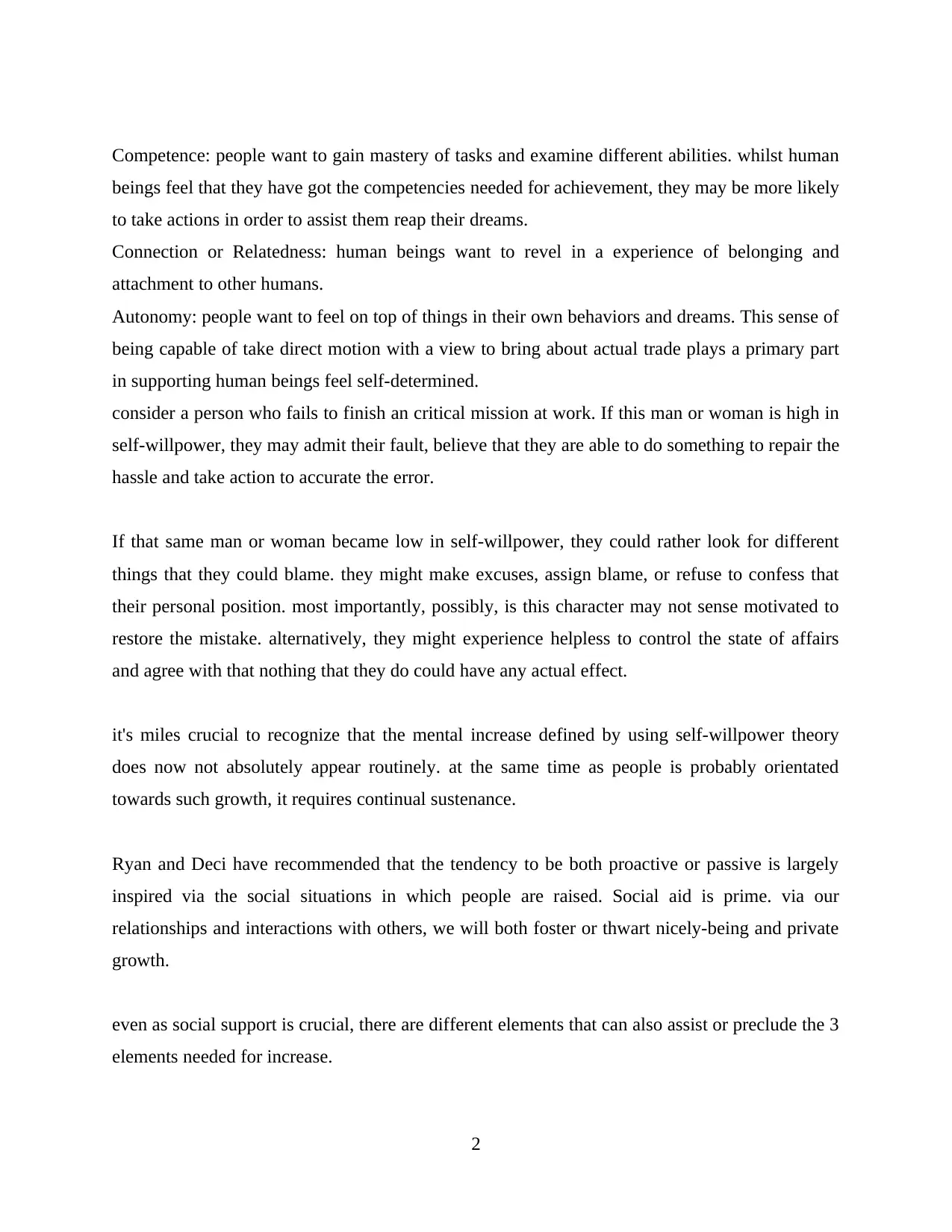
Competence: people want to gain mastery of tasks and examine different abilities. whilst human
beings feel that they have got the competencies needed for achievement, they may be more likely
to take actions in order to assist them reap their dreams.
Connection or Relatedness: human beings want to revel in a experience of belonging and
attachment to other humans.
Autonomy: people want to feel on top of things in their own behaviors and dreams. This sense of
being capable of take direct motion with a view to bring about actual trade plays a primary part
in supporting human beings feel self-determined.
consider a person who fails to finish an critical mission at work. If this man or woman is high in
self-willpower, they may admit their fault, believe that they are able to do something to repair the
hassle and take action to accurate the error.
If that same man or woman became low in self-willpower, they could rather look for different
things that they could blame. they might make excuses, assign blame, or refuse to confess that
their personal position. most importantly, possibly, is this character may not sense motivated to
restore the mistake. alternatively, they might experience helpless to control the state of affairs
and agree with that nothing that they do could have any actual effect.
it's miles crucial to recognize that the mental increase defined by using self-willpower theory
does now not absolutely appear routinely. at the same time as people is probably orientated
towards such growth, it requires continual sustenance.
Ryan and Deci have recommended that the tendency to be both proactive or passive is largely
inspired via the social situations in which people are raised. Social aid is prime. via our
relationships and interactions with others, we will both foster or thwart nicely-being and private
growth.
even as social support is crucial, there are different elements that can also assist or preclude the 3
elements needed for increase.
2
beings feel that they have got the competencies needed for achievement, they may be more likely
to take actions in order to assist them reap their dreams.
Connection or Relatedness: human beings want to revel in a experience of belonging and
attachment to other humans.
Autonomy: people want to feel on top of things in their own behaviors and dreams. This sense of
being capable of take direct motion with a view to bring about actual trade plays a primary part
in supporting human beings feel self-determined.
consider a person who fails to finish an critical mission at work. If this man or woman is high in
self-willpower, they may admit their fault, believe that they are able to do something to repair the
hassle and take action to accurate the error.
If that same man or woman became low in self-willpower, they could rather look for different
things that they could blame. they might make excuses, assign blame, or refuse to confess that
their personal position. most importantly, possibly, is this character may not sense motivated to
restore the mistake. alternatively, they might experience helpless to control the state of affairs
and agree with that nothing that they do could have any actual effect.
it's miles crucial to recognize that the mental increase defined by using self-willpower theory
does now not absolutely appear routinely. at the same time as people is probably orientated
towards such growth, it requires continual sustenance.
Ryan and Deci have recommended that the tendency to be both proactive or passive is largely
inspired via the social situations in which people are raised. Social aid is prime. via our
relationships and interactions with others, we will both foster or thwart nicely-being and private
growth.
even as social support is crucial, there are different elements that can also assist or preclude the 3
elements needed for increase.
2
Paraphrase This Document
Need a fresh take? Get an instant paraphrase of this document with our AI Paraphraser
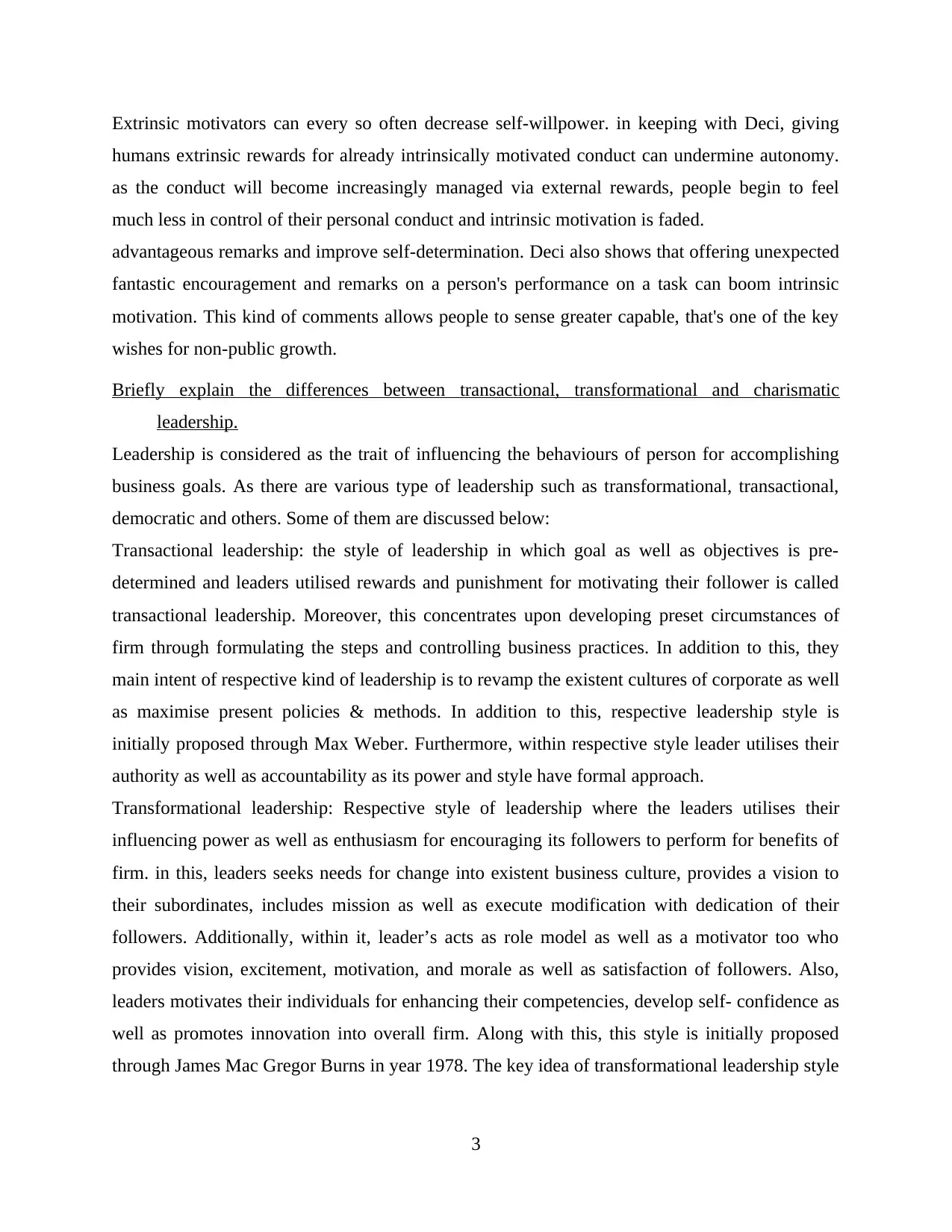
Extrinsic motivators can every so often decrease self-willpower. in keeping with Deci, giving
humans extrinsic rewards for already intrinsically motivated conduct can undermine autonomy.
as the conduct will become increasingly managed via external rewards, people begin to feel
much less in control of their personal conduct and intrinsic motivation is faded.
advantageous remarks and improve self-determination. Deci also shows that offering unexpected
fantastic encouragement and remarks on a person's performance on a task can boom intrinsic
motivation. This kind of comments allows people to sense greater capable, that's one of the key
wishes for non-public growth.
Briefly explain the differences between transactional, transformational and charismatic
leadership.
Leadership is considered as the trait of influencing the behaviours of person for accomplishing
business goals. As there are various type of leadership such as transformational, transactional,
democratic and others. Some of them are discussed below:
Transactional leadership: the style of leadership in which goal as well as objectives is pre-
determined and leaders utilised rewards and punishment for motivating their follower is called
transactional leadership. Moreover, this concentrates upon developing preset circumstances of
firm through formulating the steps and controlling business practices. In addition to this, they
main intent of respective kind of leadership is to revamp the existent cultures of corporate as well
as maximise present policies & methods. In addition to this, respective leadership style is
initially proposed through Max Weber. Furthermore, within respective style leader utilises their
authority as well as accountability as its power and style have formal approach.
Transformational leadership: Respective style of leadership where the leaders utilises their
influencing power as well as enthusiasm for encouraging its followers to perform for benefits of
firm. in this, leaders seeks needs for change into existent business culture, provides a vision to
their subordinates, includes mission as well as execute modification with dedication of their
followers. Additionally, within it, leader’s acts as role model as well as a motivator too who
provides vision, excitement, motivation, and morale as well as satisfaction of followers. Also,
leaders motivates their individuals for enhancing their competencies, develop self- confidence as
well as promotes innovation into overall firm. Along with this, this style is initially proposed
through James Mac Gregor Burns in year 1978. The key idea of transformational leadership style
3
humans extrinsic rewards for already intrinsically motivated conduct can undermine autonomy.
as the conduct will become increasingly managed via external rewards, people begin to feel
much less in control of their personal conduct and intrinsic motivation is faded.
advantageous remarks and improve self-determination. Deci also shows that offering unexpected
fantastic encouragement and remarks on a person's performance on a task can boom intrinsic
motivation. This kind of comments allows people to sense greater capable, that's one of the key
wishes for non-public growth.
Briefly explain the differences between transactional, transformational and charismatic
leadership.
Leadership is considered as the trait of influencing the behaviours of person for accomplishing
business goals. As there are various type of leadership such as transformational, transactional,
democratic and others. Some of them are discussed below:
Transactional leadership: the style of leadership in which goal as well as objectives is pre-
determined and leaders utilised rewards and punishment for motivating their follower is called
transactional leadership. Moreover, this concentrates upon developing preset circumstances of
firm through formulating the steps and controlling business practices. In addition to this, they
main intent of respective kind of leadership is to revamp the existent cultures of corporate as well
as maximise present policies & methods. In addition to this, respective leadership style is
initially proposed through Max Weber. Furthermore, within respective style leader utilises their
authority as well as accountability as its power and style have formal approach.
Transformational leadership: Respective style of leadership where the leaders utilises their
influencing power as well as enthusiasm for encouraging its followers to perform for benefits of
firm. in this, leaders seeks needs for change into existent business culture, provides a vision to
their subordinates, includes mission as well as execute modification with dedication of their
followers. Additionally, within it, leader’s acts as role model as well as a motivator too who
provides vision, excitement, motivation, and morale as well as satisfaction of followers. Also,
leaders motivates their individuals for enhancing their competencies, develop self- confidence as
well as promotes innovation into overall firm. Along with this, this style is initially proposed
through James Mac Gregor Burns in year 1978. The key idea of transformational leadership style
3
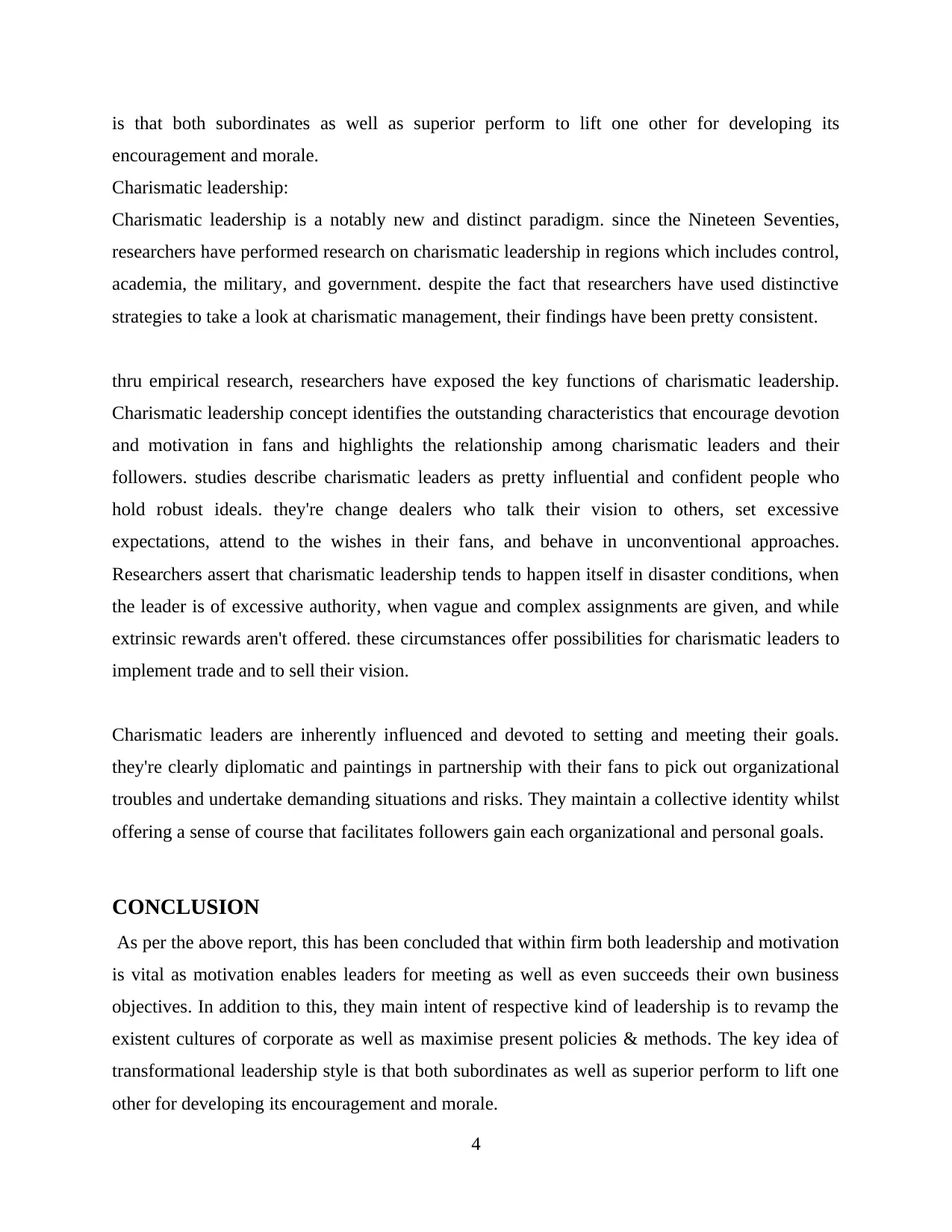
is that both subordinates as well as superior perform to lift one other for developing its
encouragement and morale.
Charismatic leadership:
Charismatic leadership is a notably new and distinct paradigm. since the Nineteen Seventies,
researchers have performed research on charismatic leadership in regions which includes control,
academia, the military, and government. despite the fact that researchers have used distinctive
strategies to take a look at charismatic management, their findings have been pretty consistent.
thru empirical research, researchers have exposed the key functions of charismatic leadership.
Charismatic leadership concept identifies the outstanding characteristics that encourage devotion
and motivation in fans and highlights the relationship among charismatic leaders and their
followers. studies describe charismatic leaders as pretty influential and confident people who
hold robust ideals. they're change dealers who talk their vision to others, set excessive
expectations, attend to the wishes in their fans, and behave in unconventional approaches.
Researchers assert that charismatic leadership tends to happen itself in disaster conditions, when
the leader is of excessive authority, when vague and complex assignments are given, and while
extrinsic rewards aren't offered. these circumstances offer possibilities for charismatic leaders to
implement trade and to sell their vision.
Charismatic leaders are inherently influenced and devoted to setting and meeting their goals.
they're clearly diplomatic and paintings in partnership with their fans to pick out organizational
troubles and undertake demanding situations and risks. They maintain a collective identity whilst
offering a sense of course that facilitates followers gain each organizational and personal goals.
CONCLUSION
As per the above report, this has been concluded that within firm both leadership and motivation
is vital as motivation enables leaders for meeting as well as even succeeds their own business
objectives. In addition to this, they main intent of respective kind of leadership is to revamp the
existent cultures of corporate as well as maximise present policies & methods. The key idea of
transformational leadership style is that both subordinates as well as superior perform to lift one
other for developing its encouragement and morale.
4
encouragement and morale.
Charismatic leadership:
Charismatic leadership is a notably new and distinct paradigm. since the Nineteen Seventies,
researchers have performed research on charismatic leadership in regions which includes control,
academia, the military, and government. despite the fact that researchers have used distinctive
strategies to take a look at charismatic management, their findings have been pretty consistent.
thru empirical research, researchers have exposed the key functions of charismatic leadership.
Charismatic leadership concept identifies the outstanding characteristics that encourage devotion
and motivation in fans and highlights the relationship among charismatic leaders and their
followers. studies describe charismatic leaders as pretty influential and confident people who
hold robust ideals. they're change dealers who talk their vision to others, set excessive
expectations, attend to the wishes in their fans, and behave in unconventional approaches.
Researchers assert that charismatic leadership tends to happen itself in disaster conditions, when
the leader is of excessive authority, when vague and complex assignments are given, and while
extrinsic rewards aren't offered. these circumstances offer possibilities for charismatic leaders to
implement trade and to sell their vision.
Charismatic leaders are inherently influenced and devoted to setting and meeting their goals.
they're clearly diplomatic and paintings in partnership with their fans to pick out organizational
troubles and undertake demanding situations and risks. They maintain a collective identity whilst
offering a sense of course that facilitates followers gain each organizational and personal goals.
CONCLUSION
As per the above report, this has been concluded that within firm both leadership and motivation
is vital as motivation enables leaders for meeting as well as even succeeds their own business
objectives. In addition to this, they main intent of respective kind of leadership is to revamp the
existent cultures of corporate as well as maximise present policies & methods. The key idea of
transformational leadership style is that both subordinates as well as superior perform to lift one
other for developing its encouragement and morale.
4
⊘ This is a preview!⊘
Do you want full access?
Subscribe today to unlock all pages.

Trusted by 1+ million students worldwide

5
Paraphrase This Document
Need a fresh take? Get an instant paraphrase of this document with our AI Paraphraser
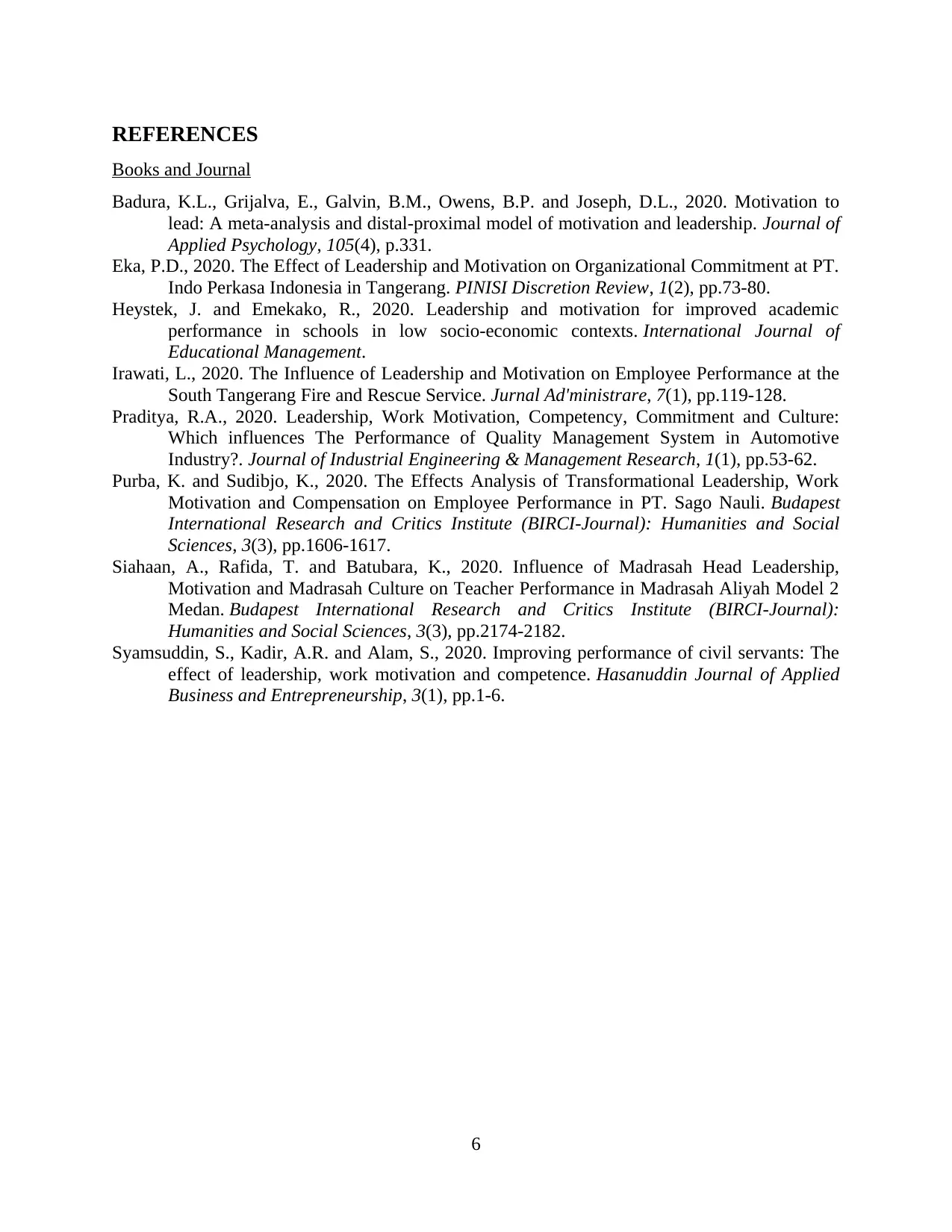
REFERENCES
Books and Journal
Badura, K.L., Grijalva, E., Galvin, B.M., Owens, B.P. and Joseph, D.L., 2020. Motivation to
lead: A meta-analysis and distal-proximal model of motivation and leadership. Journal of
Applied Psychology, 105(4), p.331.
Eka, P.D., 2020. The Effect of Leadership and Motivation on Organizational Commitment at PT.
Indo Perkasa Indonesia in Tangerang. PINISI Discretion Review, 1(2), pp.73-80.
Heystek, J. and Emekako, R., 2020. Leadership and motivation for improved academic
performance in schools in low socio-economic contexts. International Journal of
Educational Management.
Irawati, L., 2020. The Influence of Leadership and Motivation on Employee Performance at the
South Tangerang Fire and Rescue Service. Jurnal Ad'ministrare, 7(1), pp.119-128.
Praditya, R.A., 2020. Leadership, Work Motivation, Competency, Commitment and Culture:
Which influences The Performance of Quality Management System in Automotive
Industry?. Journal of Industrial Engineering & Management Research, 1(1), pp.53-62.
Purba, K. and Sudibjo, K., 2020. The Effects Analysis of Transformational Leadership, Work
Motivation and Compensation on Employee Performance in PT. Sago Nauli. Budapest
International Research and Critics Institute (BIRCI-Journal): Humanities and Social
Sciences, 3(3), pp.1606-1617.
Siahaan, A., Rafida, T. and Batubara, K., 2020. Influence of Madrasah Head Leadership,
Motivation and Madrasah Culture on Teacher Performance in Madrasah Aliyah Model 2
Medan. Budapest International Research and Critics Institute (BIRCI-Journal):
Humanities and Social Sciences, 3(3), pp.2174-2182.
Syamsuddin, S., Kadir, A.R. and Alam, S., 2020. Improving performance of civil servants: The
effect of leadership, work motivation and competence. Hasanuddin Journal of Applied
Business and Entrepreneurship, 3(1), pp.1-6.
6
Books and Journal
Badura, K.L., Grijalva, E., Galvin, B.M., Owens, B.P. and Joseph, D.L., 2020. Motivation to
lead: A meta-analysis and distal-proximal model of motivation and leadership. Journal of
Applied Psychology, 105(4), p.331.
Eka, P.D., 2020. The Effect of Leadership and Motivation on Organizational Commitment at PT.
Indo Perkasa Indonesia in Tangerang. PINISI Discretion Review, 1(2), pp.73-80.
Heystek, J. and Emekako, R., 2020. Leadership and motivation for improved academic
performance in schools in low socio-economic contexts. International Journal of
Educational Management.
Irawati, L., 2020. The Influence of Leadership and Motivation on Employee Performance at the
South Tangerang Fire and Rescue Service. Jurnal Ad'ministrare, 7(1), pp.119-128.
Praditya, R.A., 2020. Leadership, Work Motivation, Competency, Commitment and Culture:
Which influences The Performance of Quality Management System in Automotive
Industry?. Journal of Industrial Engineering & Management Research, 1(1), pp.53-62.
Purba, K. and Sudibjo, K., 2020. The Effects Analysis of Transformational Leadership, Work
Motivation and Compensation on Employee Performance in PT. Sago Nauli. Budapest
International Research and Critics Institute (BIRCI-Journal): Humanities and Social
Sciences, 3(3), pp.1606-1617.
Siahaan, A., Rafida, T. and Batubara, K., 2020. Influence of Madrasah Head Leadership,
Motivation and Madrasah Culture on Teacher Performance in Madrasah Aliyah Model 2
Medan. Budapest International Research and Critics Institute (BIRCI-Journal):
Humanities and Social Sciences, 3(3), pp.2174-2182.
Syamsuddin, S., Kadir, A.R. and Alam, S., 2020. Improving performance of civil servants: The
effect of leadership, work motivation and competence. Hasanuddin Journal of Applied
Business and Entrepreneurship, 3(1), pp.1-6.
6
1 out of 8
Related Documents
Your All-in-One AI-Powered Toolkit for Academic Success.
+13062052269
info@desklib.com
Available 24*7 on WhatsApp / Email
![[object Object]](/_next/static/media/star-bottom.7253800d.svg)
Unlock your academic potential
Copyright © 2020–2025 A2Z Services. All Rights Reserved. Developed and managed by ZUCOL.




